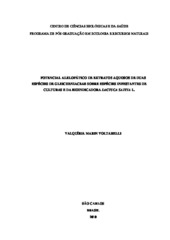Potencial alelopático de extratos aquosos de duas espécies de Gleicheniaceae sobre espécies infestantes de culturas e da bioindicadora Lactuca sativa L

Visualizar/
Data
2010-05-05Autor
Voltarelli, Valquíria Marin
Metadata
Mostrar registro completoResumo
This work aims to determine through bioassays the allelopathic potential of aqueous extracts Gleichenella pectinata and Dicranopteris flexuosa adult and mature fronds in two physiological stages (fertile and sterile) over the percentage and average time of germination, besides initial growth of three species of crop weeds (Echinochloa crus-galli, Ipomoea grandifolia, Euphorbia heterophylla). Four aqueous treatments were made (0, 2,5 , 5 and 10%), with five replications. Each plot consisted of 30 seeds for germination tests and 10 seedlings for initial growth of root and hypocotyl / coleoptile. Root growth was the most sensitive parameter to G. pectinata and D. flexuosa allelochemicals, for the three target species. All extracts damaged root growth of target species, excepting the lower concentration of sterile fronds extracts over E. heterophylla. Sterile frond extracts caused a delay on E. crusgalli and E. heterophylla germination under concentrations 5 and 10%. The higher concentration of fertile frond extract decreased germination percentage of the three target species. All D. flexuosa extracts decreased root length of all target species. I. grandifolia was the most sensitive species due to D. flexuosa extracts, having showed decrease in all morphologic parameters. Both other target species also had their shoot part length growth suppressed under 5% and 10% concentrations. A soil experiment was also performed in order to verify the role of different treatments of D. flexuosa fronds on Lactuca sativa germination in presence or absence of microorganisms. Each treatment was tested with 4 lettuce seeds per vase, by 10 days with 6 replications. Treatments were tested in 6 periods of ten days each, related to the 1st, 2nd, 4th, 8th, 16th and 32nd days after treatments application. Light, moisture and temperature conditions were controlled. In general, non-sterilized substrates presented higher allelopathic effects over analyzed parameters. Among treatments, the pre-occupied soil exerted stronger effects, with inhibition of germination in non-sterilized, during the whole period of experiment. That must be an indicative of accumulated allelopathic substances under environmental conditions, and their prolonged effects.